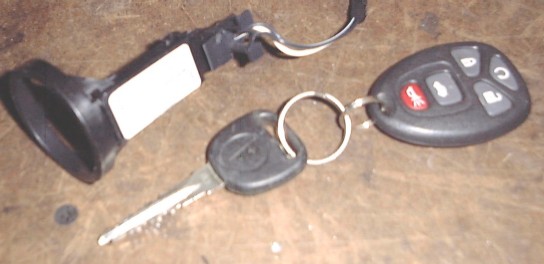
2005 Pontiac Grand Prix GXP LS4 DoD 4T65E TAPShift powertrain swap into a Pontiac Fiero
PAGE 12
I started the engine up
-- without reprogramming the ECM. While the engine ran but shut off after 2 sec
because of the missing security system/BCM, this confirmed one important thing I
was wondering about (and needed to know)... The starter crank signal comes from
the key and goes only to the BCM. The BCM sends the crank signal out to the ECM
via the Class 2 Serial Data link. The ECM activates a starter relay directly to
enable engine cranking. There is no direct connection between the ignition
switch and the starter on the Grand Prix GXP. I didn't know whether or not the
engine would run if it was cranked without BCM intervention. Well now we know.
Another thing I wasn't sure about was the charging system. The alternator is
controlled directly by the ECM. But there is a battery current sensor (inductive
pickup sensor that goes around the negative battery cable) that connects
directly to the BCM. When I started the engine, before it shut off due to the
theft system the charging system wasn't working. So the question came up: Will
the charging system work without the BCM being present?
Today I was able to go to the dealership to get the correct factory programming
flashed onto this replacement ECM. Once I got back to the shop, I used the HP
Tuners software to disable the VATS functions within the ECM. Then it was time
to confirm another unknown (that was debated hotly in the Old Europe version of
this thread)....
IT RUNS!!! No theft shutoff or other issues! The HP Tuners software WORKS AS
ADVERTISED for this application (in being able to disable the VATS). The BCM
isn't even installed in the car yet. Also, the charging system came to life
after the engine ran for about 4 seconds and maintained a 14.4 volt charge while
the engine ran. The car is not drivable yet due to a missing wheel and tire
(supplier/vendor) which I hope shows up early next week. I am going to see if I
can get an audio recording posted to the internet of the exhaust note later.
Now, moving on there is still a lot left to do on the interior. The tach doesn't
work but there are some different settings for the tach output in this ECM that
I am going to try before I try some things electronically at the tach. I also
want to get the paddleshifters installed and hooked up to the TCM so I can see
if those work as intended. Then there's still much more BCM wiring. But at least
it runs.

Pictured above is a PK3
module taken off an ignition cylinder, a PK3 master key, and a remote
entry/start fob which is supposed to be compatible with the BCM I am installing
in this application. As you can see, the PK3 module is quite small in size which
means it could be mounted virtually anywhere in a Fiero. As I said earlier I am
going to research the option of installing this module in a swap should someone
wish to have this security feature.
Here is a picture of the finished exhaust system before I installed it into the car...
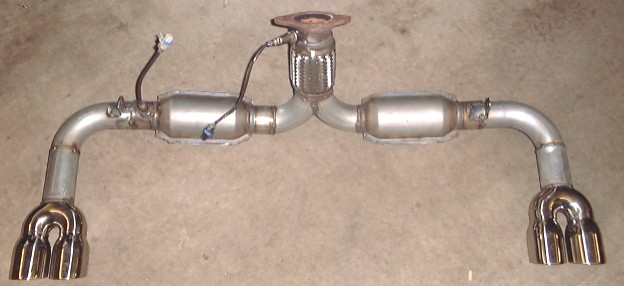
More about the BCM and
DIC. The main reason why the BCM was installed into this car was because the
customer wanted the factory GXP remote keyless entry, remote start, and alarm
functions as well as the DIC to work. The DIC will not work without the BCM.
As mentioned earlier, pretty much the ENTIRE electrical system of the GXP runs
thru the BCM (more than 100 wires). Everything from interior and exterior lights
to windshield wipers. The BCM also is responsible for telling the ECM, TCM, and
other devices in the car when the ignition key is in off, assy, on, or crank
positions. On the GXP and other modern GM cars with BCMs, there are only a few
small wires that actually connect to the ignition switch. The bulk of current
switching is done by the BCM. The BCM also monitors several inputs and outputs
to determine when to turn on lights, activate output functions, display
warning/error messages on the DIC, etc.
Before I hooked up the BCM, it was unclear just how many circuits that go to it
could be omitted before it would suspend functioning of the keyless entry/start
and alarm options. Basically I found out a lot of stuff didn't need to be hooked
up for those functions to work; and below is a basic list of the inputs/outputs
that I ended up using...
INPUTS:
Battery Power
Ground
Fiero Ignition switch output: assy, on, crank
Ignition key "in cylinder" monitor
Door, hood, and trunk ajar switches
Brake Pedal Position Sensor
Battery Current Sensor
Remote Keyless Receiver Module
DIC and Compass Module
PassKey 3 (PK3) exciter/receiver module
Dimmer potentiometer for DIC dimming control (OE Fiero dimmer is incompatible)
OUTPUTS:
Dome, interior, and trunk lights power supply
RAP (retained assy power) relay - (used to keep power flowing to the radio when
the key is turned off, will shut down when door is opened or preset time limit
expires)
Main Ignition Power supply relay (powers up ECM, TCM, TwistMachine TAPshift
receiver module)
Vehicle Content Theft Deterrent (alarm) indicator LED
Parking lamps relay
Backup lights
Door lock/unlock relays
Horn
Trunk release solenoid
I think that pretty much covers it. I used my GM TECH 2 scanner to program the
key fob remote to the BCM and everything functions great. In the GXP, the
keyless remote receiver module was wired up to an antenna grid on the back
window of the car. Since the Fiero had no such grid, I had to come up with
something else. As it turns out, this car had one of those old school cell phone
antennas mounted to the back window that we ended up using as the antenna for
the remote keyless system and the range seems to be pretty good.
Now about the PK3 system... The PK3 system had to be wired up to prevent a theft
system warning message from being constantly displayed on the DIC (there was no
way to get this warning message off the DIC by hitting buttons). I consulted the
customer about how he wanted this system installed and it was decided that a
slot be cut in the center console ALDL and cig lighter cover plate so the PK3
key could be inserted to bypass the system (the PK3 exciter/receiver module is
mounted under the center console just behind the cover plate). This key doesn't
have to be turned or anything fancy in order for the PK3 system to read it; in
fact, it doesn't even have to be in the slot I cut for it. Just has to lay near
the exciter/receiver module in order for the system to "see" it. The key can be
removed from the slot or the area of the module to render the car inoperable for
theft deterrent purposes.
Concerning the DIC, it does display some warning messages for the ABS and
Stability control systems when the key is turned on. There is no way I can get
around this unless I install the ABS computer and satisfy it's inputs so it
won't set any trouble codes (which would end up triggering these same warning
messages on the DIC anyway). But the good news is these warning messages can be
cycled thru by hitting a button a couple of times on the DIC and they go away
for the continuation of vehicle operation. The DIC displays transmission temp,
oil life, mileage, trip odometer, compass info, transmission gear position (or
current gear if in TAPShift mode) as well as a host of warning messages for such
things is hot engine temp, engine oil pressure low, engine oil level low, etc.
Unfortunately one of the functions I was not able to make work is the G-force
readouts. The sensor for these functions is part of the stability control system
which connects directly to the ABS computer; and there's no way to hook it up to
the BCM without having the ABS computer hooked up as well. The other thing I
can't make work right is the fuel economy computer readout on the DIC. The ECM
monitors fuel level in the tank directly, and then sends out a fuel level signal
to the BCM, DIC, and GXP instrument cluster over the data line. The type of
sender (and it's resistance values) used in the GXP is different than what the
OE Fiero sending unit uses; and my attempts to merge the two systems using
resistors didn't work without altering the fuel gauge reading on the Fiero's
instrument cluster significantly. I suppose the GXP fuel level sensor could be
installed in the Fiero tank alongside the OE sender (if there's enough room),
but even if it was, the ECM is programmed for a bigger capacity fuel tank than
what the Fiero has so it's doubtful the fuel econ computer would give accurate
data to the driver anyway. Furthermore, I'm sure vehicle weight is a factor in
making fuel economy calculations and I don't know where the values for these are
stored and if they can be changed (might be stored in the BCM or DIC, neither of
which can be custom programmed at this time).
One of the neat features alotted for by having the BCM wired up is the
interior/trunk lights is even if you accidently leave any of these on, the BCM
will shut them down after a preset time limit. So no worries about leaving the
doors or trunk lid open at car shows because the BCM will make sure the battery
doesn't go dead.
Now if you had fun reading all of this, imagine how much fun it was to wire it
up!
Now I would like to cover a few major points encountered in this swap...
SPEEDO:
I was not able to use the VSS output to radio the ECM has because it wasn't a
signal I could get the Fiero speedo to recognize. I was able to get the Fiero
speedo to recognize the VSS signal coming out of the TCM going into the ECM, but
it was reading about 6.5x too fast. I contacted Dakota Digital and ordered their
SGI-5 speedo signal interface module. This unit is fully programmable on-the-fly
and ended up working great for this application. I did have to run the Fiero
speedo off the SGI-5's "2000ppm oc" output (usually used for older ECMs and
cruise controls) in order for it to work tho. Also had to run the output signal
from the SGI-5 thru the Fiero speedo conversion circuit I have shown here:
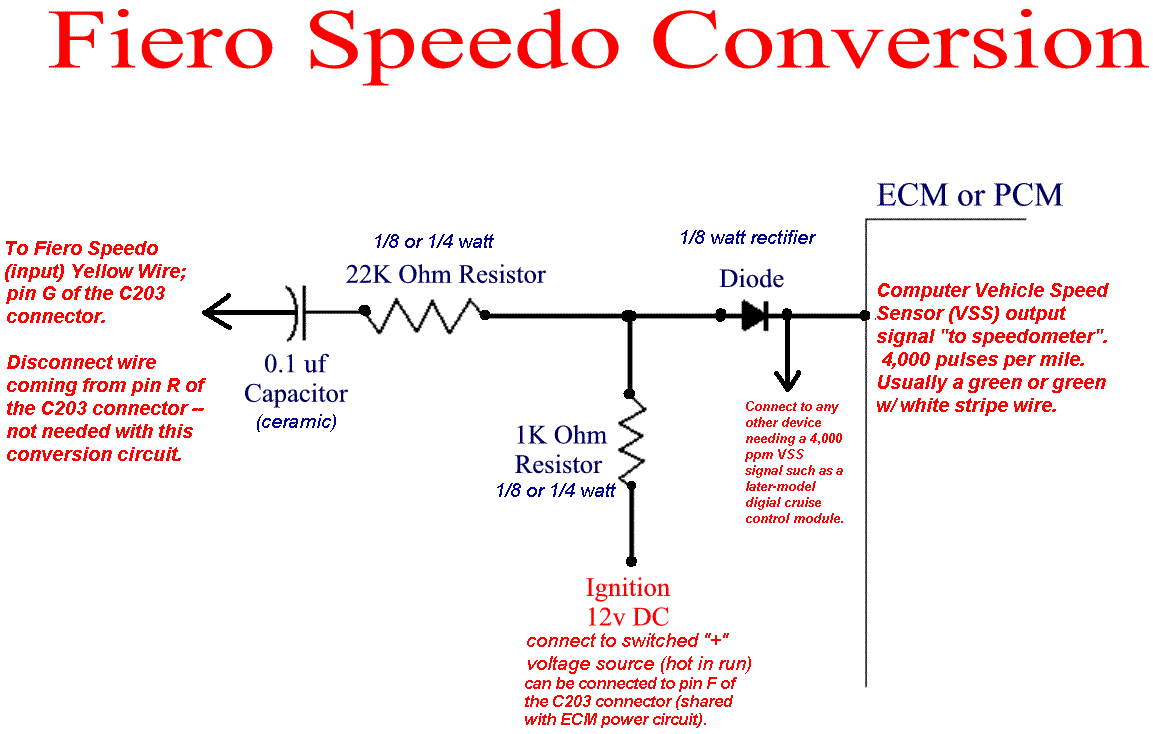
TACH:
The ECM has a tach output. At first, I was unable to get the Fiero's tach to
recognize this signal; but then I realized it is used to seeing a signal that
has a 12v bias (because it is coming off the ignition coil and gets pulled to
ground when the ign module commands the coil to fire). Apparently, the ECM only
puts out a ground pulse with no compatible positive power bias, and the Fiero's
tach couldn't recognize this. All I had to do to get it to work was run a wire
from an IGN 12v + source thru a 22k ohm resistor, then tied that into the
existing tach wire. With this done the tach was registering engine RPM, but
appeared to be 1/3 too slow reading vs. actual engine RPM. Back in the day I had
the reverse problem when I wanted to get a 4cyl tach to work with a V6. All I
had to do to resolve that issue was to replace the calibration capacitor with
one that had a lower uF rating than stock (stock = 0.009uF and I replaced it
with 0.006uF to correct the reading). Turns out this stock V6 tach had the same
0.009uF capacitor in the same location on the curcuit board as that 4cyl unit
had. I had a tough time finding the correct capacitor I needed so I ran two in a
parallel circuit to get the 0.0114uF rating I needed and it seems to be dead on
with the scan tool says the actual engine RPM is doing. A picture showing the
location of the capacitor in question can be seen here:
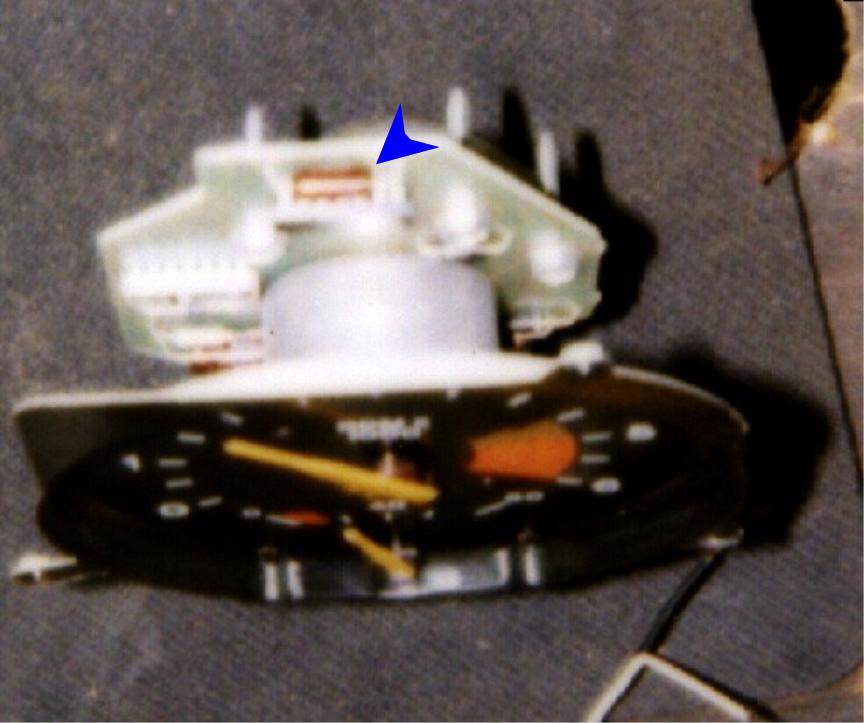
DIC MOUNTING:
I took the liberty of fab'ing up a mounting bracket so I could put the DIC up on
the dash (using existing OE dash trim mounting screws) temporarily. The owner
informs me that he plans on doing a custom dash sometime in the future, but
until then I still want him to be able to use (and see) the DIC. Below is a
picture of where I put the DIC and you can also see the new MOMO steering wheel
and paddle shifter setup...
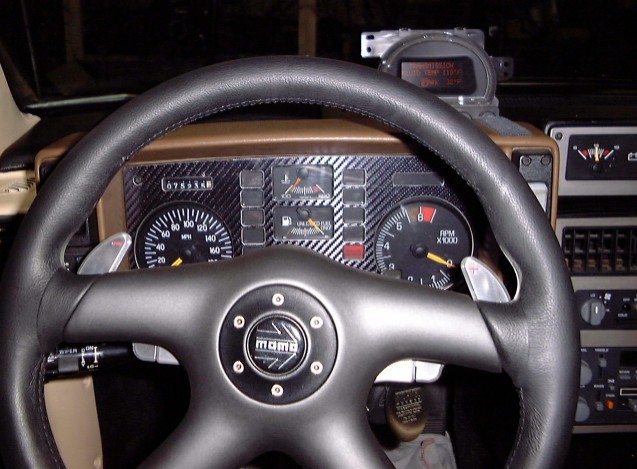
DRIVING IMPRESSIONS (so
far):
I still have some tuning to do. For one thing the DoD seems to want to kick in
at speeds as slow as 25mph and during light-moderate acceleration which is kind
of annoying. There is a constant in the tuning software I am using that is
supposed to allow me to set the MPH qualifier for DoD to kick in but I've tried
many different settings here and nothing has had an effect so for. So I am going
to contact tech support and see what can be done. I did find min/max RPM
qualifiers for DoD operation and those do work, so I can at least somewhat work
around this for now in case tech support for the tuning software I am using
can't resolve the issue.
Transmission shift points and firmness still need some tweaking but it's getting
close. As with many aspects of tuning, things like this can only be ironed out
on the road and require some driving time to get right. A dyno is pretty much
useless for this aspect of the tuning.
Idle, part throttle cruising, and light-moderate acceleration fuel and spark
seem to be very close to where they need to be. Haven't been able to do many WOT
blasts around here with the slick conditions. But those I have been able to do
showed the engine is right at home in a (roughly) 700lb less body than it is
used to. This engine has more than enough power to spin the tires upon request
at low speeds or from a dead stop and it has pretty long legs for the big end.
The exhaust note this engine makes at full song is possibly the best I've heard
coming from an exhaust system running only cats and resonated tips (thanks to
the LSx's revised firing order vs. conventional SBC); despite the fact it is a
tad on the loud side. The interior drone on the highway isn't any worse (might
even be less so) than what 3800's put out with the same exhaust system. To be
quite honest this thing really doesn't make its presence known until you get
into it a bit. But when you do, it will definitely turn heads.
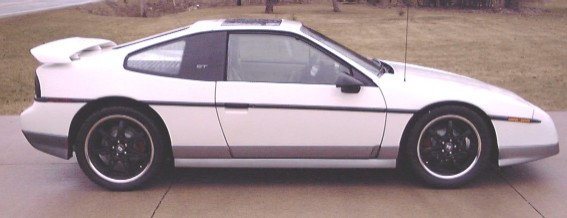
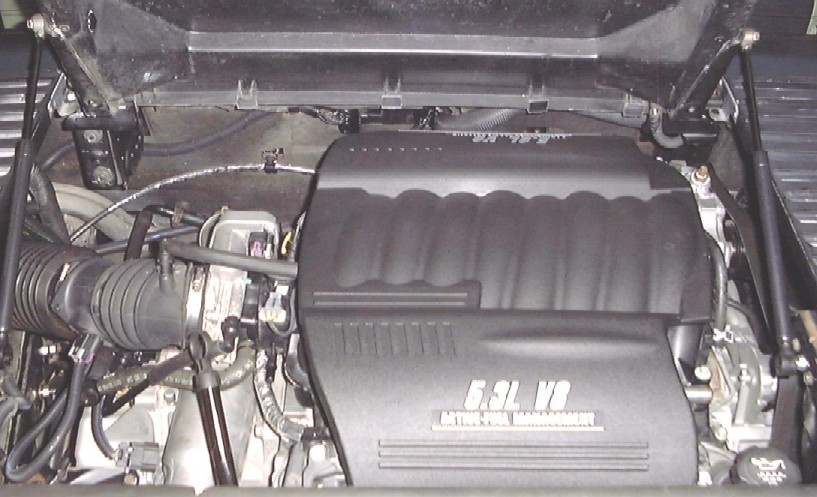
Swap Page 1 2 3 4 5 6 7 8 9 10 11 12 13